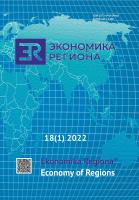Geographic Concentration of Economic Activities in Aburrá Sur in Antioquia (Colombia) — A Reinterpretation of the Industrialisation Coefficients of the Stochastic Independence Approach
Geographic Concentration of Economic Activities in Aburrá Sur in Antioquia (Colombia) — A Reinterpretation of the Industrialisation Coefficients of the Stochastic Independence Approach
Author(s): Robert Ng Henao, Isabel Cristina Betancur Hinestroza, Abraham Allec Londoño PinedaSubject(s): Economy, National Economy, Business Economy / Management, Public Finances, Socio-Economic Research
Published by: Институт экономики Уральского отделения Российской академии наук
Keywords: local economic development; public policies; business competitiveness; territorial localisation; territorial productivity; Aburrá Sur; economic geography; Stochastic Independence Approach;
Summary/Abstract: In terms of economic geography, spatial and industrial concentration represents an increasingly important input for the design of public policies that foster local economic development and productive transformation of a territory. This analysis aims to identify the geographic concentration indices of different sectors in which the economic activity is distributed in each of the five municipalities that are part of the territorial agglomeration of Aburrá Sur in the department of Antioquia (Colombia). The methodology is based on a reinterpretation of the industrialisation coefficients used in the stochastic independence approach, which explains the divergences between specialisation levels of production and geographical concentration by using entropy indices that consider the reference distribution as uniform distribution, as is the case with maximum dispersion. We start from the hypothesis that in the municipalities belonging to the Aburrá Sur predominates the high concentration in the manufacturing industry, although some of them could have medium and even low concentration because they have different sector indicators. Results show that the manufacturing industry is the most concentrated sector in the territorial agglomeration. The research findings can be used by political and economic actors in the territory for designing strategies and decision-making on sectoral strategic development commitments.
Journal: Экономика региона
- Issue Year: 18/2022
- Issue No: 1
- Page Range: 64-77
- Page Count: 14
- Language: English

